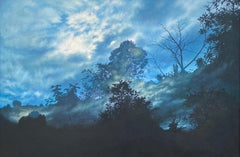Eleanor Voorhees
Recent Sales
1970s Photorealist Landscape Paintings
Canvas, Acrylic
1970s Photorealist Landscape Paintings
Canvas, Acrylic
1990s Photorealist Still-life Paintings
Acrylic
1850s Cubist Figurative Paintings
Oil, Panel
Early 2000s Photorealist Still-life Paintings
Oil
Ian Hornak for sale on 1stDibs
Painter and draftsman Ian Hornak created vivid hyperrealist and Photorealist works, and was celebrated for his visionary incorporation of multiple-exposure photography into his landscape paintings.
The subject matter at the heart of the world’s finest Photorealist works flickers between crystal-clear reality and dreamy illusion, and Hornak’s representational art is just as compelling, enveloping the viewer with rich imagery and vibrant colors.
The painter was born John Francis Hornak in Philadelphia to Slovakian immigrants who moved to New York when he was still an infant. He became enamored of visual art at an early age — for his ninth birthday, Hornak received a set of oil paints and a book about Renaissance paintings. He reproduced many of the book’s photos of the works of Michelangelo, Leonardo da Vinci and others so well that they looked like the photographs themselves.
Hornak studied art at the University of Michigan and Wayne State University. After earning his bachelor's and master's degrees in fine arts, he moved to New York City in 1968 and befriended Lowell Nesbitt. The realist artist introduced him to Willem de Kooning, Robert Motherwell, Robert Indiana and others. Hornak resisted the Abstract Expressionist and Pop styles of the era, instead creating work that was noted for its Surrealist and even Romantic elements.
In 1970, Hornak debuted his first paintings in his multiple-exposure style. A year later, the Tibor de Nagy Gallery hosted his first New York City solo exhibition, and his prominence in the art world grew. From 1986 until his death in 2002, Hornak produced botanical and still-life paintings inspired by Flemish and Dutch masters.
Hornak’s work can be found in the permanent collections of many institutions, such as the Smithsonian American Art Museum, the Smithsonian National Museum of American History and the Library of Congress.
On 1stDibs, find authentic Ian Hornak paintings, drawings, prints and more.
A Close Look at photorealist Art
A direct challenge to Abstract Expressionism’s subjectivity and gestural vigor, Photorealism was informed by the Pop predilection for representational imagery, popular iconography and tools, like projectors and airbrushes, borrowed from the worlds of commercial art and design.
Whether gritty or gleaming, the subject matter favored by Photorealists is instantly, if vaguely, familiar. It’s the stuff of yellowing snapshots and fugitive memories. The bland and the garish alike flicker between crystal-clear reality and dreamy illusion, inviting the viewer to contemplate a single moment rather than igniting a story.
The virtues of the “photo” in Photorealist art — infused as they are with dazzling qualities that are easily blurred in reproduction — are as elusive as they are allusive. “Much Photorealist painting has the vacuity of proportion and intent of an idiot-savant, long on look and short on personal timbre,” John Arthur wrote (rather admiringly) in the catalogue essay for Realism/Photorealism, a 1980 exhibition at the Philbrook Museum of Art, in Tulsa, Oklahoma. At its best, Photorealism is a perpetually paused tug-of-war between the sacred and the profane, the general and the specific, the record and the object.
“Robert Bechtle invented Photorealism, in 1963,” says veteran art dealer Louis Meisel. “He took a picture of himself in the mirror with the car outside and then painted it. That was the first one.”
The meaning of the term, which began for Meisel as “a superficial way of defining and promoting a group of painters,” evolved with time, and the core group of Photorealists slowly expanded to include younger artists who traded Rolleiflexes for 60-megapixel cameras, using advanced digital technology to create paintings that transcend the detail of conventional photographs.
On 1stDibs, the collection of Photorealist art includes work by Richard Estes, Ralph Goings, Chuck Close, Audrey Flack, Charles Bell and others.
Finding the Right paintings for You
Painting is an art form that has spanned innumerable cultures, with artists using the medium to tell stories, explore and communicate ideas and express themselves. To bring abstract, landscape and still-life paintings into your home is to celebrate and share in the long tradition of this discipline.
When we look at paintings, particularly those that originated in the past, we learn about history, other cultures and countries of the world. Like every other work of art, paintings — whether they are contemporary creations or works that were made during the 19th century — can often help us clearly see and understand the world around us in a meaningful and interesting way.
Cave walls were the canvases for what were arguably the world’s first landscape paintings, which depict natural scenery through art. Portrait paintings and drawings, which, along with sculpture, were how someone’s appearance was recorded prior to the advent of photography, are at least as old as Ancient Egypt. In the Netherlands, landscapes were a major theme for painters as early as the 1500s. Later, artists in Greece, Rome and elsewhere created vast wall paintings to decorate stately homes, churches and tombs. Today, creating a wall of art is a wonderful way to enhance your space, showcase beautiful pieces and tie an interior design together.
No matter your preference, whether you favor Post-Impressionist paintings, animal paintings, Surrealism, Pop art or another movement or specific period, arranging art on a blank wall allows you to evoke emotions in a room while also showing off your tastes and interests. A symmetrical wall arrangement may comprise a grid of four to six pieces or, for an odd number of works, a horizontal row. Asymmetrical arrangements, which may be small clusters of art or large, salon-style gallery walls, have a more collected and eclectic feel. Download the 1stDibs app, which includes a handy “View on Wall” feature that allows you to see how a particular artwork will look on a particular wall, and read about how to arrange wall art. And if you’re searching for the perfect palette for your interior design project, what better place to turn than to the art world’s masters of color?
On 1stDibs, you’ll find an expansive collection of paintings and other fine art for your home or office. Browse abstract paintings, portrait paintings, paintings by popular artists and more today.

